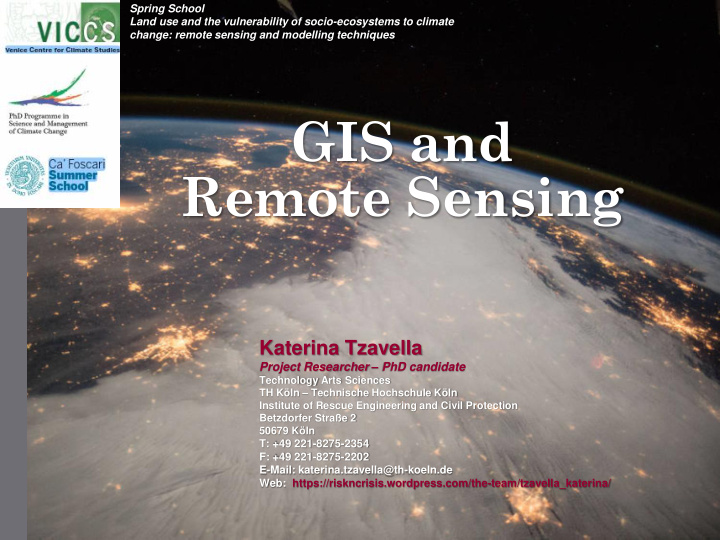



Spring School Land use and the vulnerability of socio-ecosystems to climate change: remote sensing and modelling techniques GIS and Remote Sensing Katerina Tzavella Project Researcher – PhD candidate Technology Arts Sciences TH Köln – Technische Hochschule Köln Institute of Rescue Engineering and Civil Protection Betzdorfer Straße 2 50679 Köln T: +49 221-8275-2354 F: +49 221-8275-2202 E-Mail: katerina.tzavella@th-koeln.de Web: https://riskncrisis.wordpress.com/the-team/tzavella_katerina/
Katerina Tzavella | Risk and Crisis management Overview GIS Geographical Information Systems DEM Raster data Vector data (Digital Elevation Model) Remote Satellites Sensing
Katerina Tzavella | Risk and Crisis management What is G I S ? Geographic + Information + Systems
Katerina Tzavella | Risk and Crisis management VIDEO
Katerina Tzavella | Risk and Crisis management Visualize Analyze Store Plan Information Decision Collect Making More Map GIS Is an organised collection of : 1. Hardware 2. Software 3. Network 4. Data 5. Procedures and 6. People!
Katerina Tzavella | Risk and Crisis management With GIS : put important information Geographical features of the real world on maps …
Katerina Tzavella | Risk and Crisis management Representing Geographical Features How do we describe geographical features? by recognizing two types of data : – Spatial data which describes location (where) – Attribute data which specifies characteristics at that location (what, how much, and when) How do we represent these digitally in a GIS? by grouping into layers based on similar characteristics and using either: – Vector Data – Raster Data
Katerina Tzavella | Risk and Crisis management Representing Geography The discrete object view represents the real world as objects with well defined boundaries in empty space (vector data) country borders land parcels locations streets (x 1 ,y 1 ) Lines Points Polygons The field view represents the real world as a surface divided into a regular grid of cells. They are continuous surfaces of data. (raster data) aerial photograph a satellite image a surface of chemical concentrations an elevation surface.
Katerina Tzavella | Risk and Crisis management Raster data are described by a cell grid, one value per cell Vector Raster Point Line Polygon Zone of cells
Katerina Tzavella | Risk and Crisis management
Katerina Tzavella | Risk and Crisis management Raster and Vector Data
Katerina Tzavella | Risk and Crisis management
Katerina Tzavella | Risk and Crisis management Information is organized into layers Cities Rivers Roads Lakes States 17
Katerina Tzavella | Risk and Crisis management Many ways to use GIS in the real-world! Aviation Safety Energy Forecasting Agricultural Efficiency Carbon Management Disaster Management Public Health Homeland Security Community Growth Coastal Management Invasive Species Water Management Air Quality
Katerina Tzavella | Risk and Crisis management What is Remote Sensing? Remote sensing (RS) is the collection of information about an object without being in direct physical contact with the object. 1. Energy Source or Illumination (A) 2. Radiation and the Atmosphere (B) 3. Interaction with the Object (C) 4. Recording of Energy by the Sensor (D) 5. Transmission, Reception and Processing (E) 6. Interpretation and Analysis (F) 7. Application (G)
Katerina Tzavella | Risk and Crisis management Electromagnetic Radiation (EMR) Light - can be thought of as a wave in the 'electromagnetic field' of the universe Wavelength Frequency (how many times peak passes per second) A wave can be characterized by its wavelength or its frequency Remote sensing is concerned with the measurement of EMR returned by the earth’s natural and cultural features that first receive energy from the sun or an artificial source such as a radar transmitter.
Katerina Tzavella | Risk and Crisis management Electromagnetic Radiation (EMR) Because different objects return different types and amounts of EMR, the objective in remote sensing is to detect these differences with the appropriate instruments (sensors). This makes it possible for us to identify and assess a broad range of surficial features and their conditions. The Electromagnetic (EM) Spectrum
Katerina Tzavella | Risk and Crisis management Sensors
Katerina Tzavella | Risk and Crisis management Sensors Passive sensors Landsat ASTER Quickbard Ikonos Active Sensors LIDAR RADAR
Katerina Tzavella | Risk and Crisis management Platforms Platforms are: Ground based Airborne Spaceborne Sensing from 1 meter to 36,000 km height
Katerina Tzavella | Risk and Crisis management Aerial Camera Radar Satellite (SAR) Multispectral Satellite Hyperspectral Sensor Landsat/Ikonos/Quickbard Hyperion
Katerina Tzavella | Risk and Crisis management Application of Remote sensing Urbanization & Transportation – Updating road maps – Asphalt conditions – Wetland delineation Agriculture – Crop health analysis – Precision agriculture – Compliance mapping – Yield estimation 22
Katerina Tzavella | Risk and Crisis management Natural Resource Management Habitat analysis Environmental assessment Pest/disease outbreaks Impervious surface mapping Lake monitoring Hydrology Landuse-Landcover monitoring Mineral province Geomorphology Geology National Security -Targeting - Disaster mapping and monitoring -Damage assessment -Weapons monitoring -Homeland security -Navigation -Policy 23
Katerina Tzavella | Risk and Crisis management What is a Digital Elevation Model ( DEM )? Devil’s Tower in Wyoming
Katerina Tzavella | Risk and Crisis management DEM creation a. By digitizing contours This is a ‘second hand’ digital, as contours are abstract and may result in ‘artifacts’ in the model. b. Digital stereo photogrammetry This is a better option, as it refers to the real surface captured from aerial photographs. b. Direct image grid DEM from satellites / radars U.S. Releases Enhanced Shuttle Land Elevation Data through the Shuttle Radar Topography Mission SRTM
Katerina Tzavella | Risk and Crisis management Shuttle Radar Topography Mission SRTM The Shuttle Radar Topography Mission produced the most complete and highest resolution digital elevation model of the Earth. The project was a joint endeavor of NASA, the National Geospatial-Intelligence Agency, the German and Italian Space Agencies, and flew in February 2000. It used dual radar antennas to acquire data processed to digital topographic data of very good resolution.
Recommend
More recommend